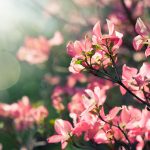Cultivate a Bee-Friendly Landscape
Bees are in trouble. About 42 percent of the nation’s bee colonies disappeared in 2015, reports the Natural Defense Council. Populations of both commercial and wild bees have been decreasing for decades, but last year marked an escalation in the trend. Bees are essential to U.S. agriculture. Many crops, including apples, cherries, almonds and avocados, depend on them to bear fruit.
Why Are Bees Dying?
The die-off is something of a mystery. Several factors may be to blame. Disease and loss of forage areas harm bees. A recent study by the Environmental Protection Agency concluded that neonicotinoid pesticides are also harmful to honeybees.
Neonicotinoid is widely used in the U.S., including in Oregon and Washington. It’s used in agriculture and garden pesticides.
How Does Neonicotinoid Harm Bees?
Bees feed on nectar from blossoms. As they travel from flower to flower, they deposit the pollen needed for plants to bear fruit. When bees collect nectar from plants sprayed with neonicotinoid, the chemical alters their brains. One effect of the pesticide is that bees become confused and can’t find their way back to their colony.
How You Can Help
Anything that stresses bee colonies, such as pesticides or a lack of habitat, makes it more vulnerable to disease. You can help bees by making simple changes in your gardening and shopping choices.
Keep Trees Healthy and Trimmed
Bees love a sunny landscape. Many bee-friendly plants need full sun. Let more sunlight into your garden by keeping your trees trimmed.
A regularly pruned tree is also healthier and can better withstand pests without the need of chemical sprays. If you have a tree that’s hazardous or diseased, remove it. Inexpensive Tree Care can help you identify a sick tree. If you’re planting a new tree, ask a local nursery to help you select a variety that’s disease and pest resistant.
Choose Bee-Friendly Plants
Flowering plants native to the Pacific Northwest are a great choice for Oregon and Washington yards, but there are many varieties of plants that are bee friendly. Here are some of the best choices for a bee-friendly garden:
- Flowers: Sunflowers, asters, honeysuckle, salvia and echinacea are easy to grow and widely available.
- Cover crops: Flowering cover crops such as clover and buckwheat provide food for bees and enrichment for the soil.
- Herbs: Lavender, thyme and oregano are nutritious for both humans and bees.
- Weeds: Dandelion and blackberry provide food for bees. Not everyone wants to grow weeds in their yard, but if you and your immediate neighbors don’t mind, bee health is a great excuse to avoid pulling weeds.
Avoid Using Pesticides
Neonicotinoid has been fingered as particularly dangerous to bees. Imidacloprid is a type of neonicotinoid. Products labeled for roses often contain it.
When pests are a present, accurately diagnose the problem and try nontoxic solutions first. Your Oregon State University Extension or Washington State University Extension branch can help you figure out what ails your plants. Local nurseries may also be able to offer advice. Physical barriers and biological controls are often a good alternative to spraying chemicals.
Support Local Beekeepers
Support your neighborhood beekeeper by buying Oregon or Washington honey and honey products. Small honey producers often work more for the love of their hobby than for profit. Because their avocation depends on healthy bees, they shower their honey producers with TLC.
Buy Organic Produce
Organic farmers don’t use pesticides or herbicides. Shop at the farmer’s market and get to know the vendors. Ask them about their pesticide use. Some farmers don’t seek an organic label, but they may still use sustainable methods.
Learn more about bees, including how to become a beekeeper at OSU’s Honey Bee Lab and WSU’s Beekeeping resources page.
Inexpensive Tree Care keeps your trees healthy through regularly pruning and trimming. Give us a call for more information about caring for your trees.




